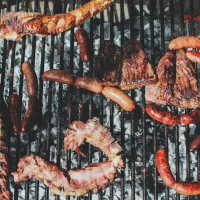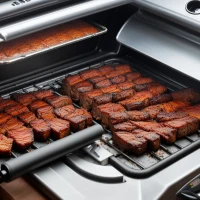When it comes to mastering the art of barbecue, brisket stands as a pinnacle of pitmaster prowess. Achieving that sought-after balance of tenderness, moisture, and flavor requires not only time and patience but also an in-depth understanding of the key element in barbecuing brisket—temperature. With the rise of plant-based diets, even vegetables can be transformed using techniques akin to brisket preparation.
Cooking the perfect brisket, whether it be meat or a vegetable alternative, is a culinary accomplishment that many strive for, but few perfect. The challenge lies in the understanding of what temperature is brisket done to perfection. In this comprehensive guide, we’ll delve into the essential knowledge and tips required to unlock the secrets of brisket preparation, ensuring a masterpiece every time you fire up the grill. Get ready to discover the ideal temperature guide that will elevate your barbecuing skills beyond measure.
Understanding Brisket and Its Vegetable Counterparts
The Meaty Brisket Basics
Brisket, the tough, flavorful cut from the lower chest of beef or veal, has long been a staple in barbecue traditions. The reason for its notoriety comes from its complexity; it demands a low and slow cooking approach to transform a notoriously tough cut into a melt-in-your-mouth delicacy.
Key factors to consider when cooking brisket include:
- Type of cut: The point or the flat, with each offering different thicknesses and fat content.
- Trimming: Properly trimming the fat cap to ensure even cooking and optimal smoke penetration.
- Seasoning: A balanced rub that complements the natural flavors of the brisket without overpowering.
The Rise of Plant-Based ‘Brisket’
As plant-based eating grows in popularity, so too does the inclination to recreate classic dishes with vegetable substitutes. A variety of vegetables, smoked and seasoned like traditional brisket, can provide a similar savory experience for those seeking vegetarian or vegan options.
Popular vegetable ‘brisket’ options include:
- Jackfruit: Known for its meaty texture, it can be seasoned and smoked to mimic brisket.
- Mushrooms: Particularly king oyster mushrooms, renowned for their substantial texture and ability to absorb flavors.
- Tempeh: Fermented soybeans pressed into a dense cake that can be sliced and treated like a brisket cut.
The Brisket Cooking Process: Meat and Plant-Based
Preparing Your Cut
Whether you’re working with meat or a hearty vegetable substitute, preparation is critical. For a traditional beef brisket, this means trimming the fat to about 1/4 inch to ensure enough fat remains to keep the meat moist without blocking smoke absorption. For vegetable alternatives, preparation involves slicing the product to mimic the thickness and shape of a traditional brisket cut—this is where texture is key.
Seasoning: The Flavor Foundation
Seasoning is more than just adding flavor; it’s about creating a crust or “bark” on the brisket. A classic rub includes salt, black pepper, garlic powder, and paprika. For a vegetable brisket, a similar rub will impart the deep flavors associated with barbecuing.
Smoking: Low and Slow
The mantra “low and slow” defines the brisket smoking process. The ideal temperature range for smoking a brisket is between 225°F and 250°F. This slow cook allows the tough fibers to break down over time, resulting in tender meat. The same principle applies to a vegetable brisket, although the temperature and time may need to be adjusted considering the different composition of vegetables.
What Temperature Is Brisket Done: Meat vs. Vegetable
Finding the ideal internal temperature for brisket, whether it’s meat or vegetable, is the secret to ensuring a tender, juicy final product.
Meat Brisket Internal Temperature Guide
The general consensus among pitmasters is that brisket reaches perfect doneness between an internal temperature of 195°F to 205°F. The exact temperature can vary depending on personal preference and the specific cut.
Vegetable Brisket Ideal Temperature
For vegetable brisket, the target is less about internal temperature and more about achieving the right tenderness and flavor. Unlike meat, vegetables don’t have collagen that needs to break down, so the cooking process is generally shorter. However, for dense vegetables like jackfruit, reaching an internal temperature similar to meat, around 165°F, can indicate tenderness and readiness.
Critical Temperatures to Monitor During Cooking
Throughout the cooking process, monitoring both the smoker’s temperature and the brisket’s internal temperature is essential. Here are crucial temperatures to keep in mind:
The Smoker’s Temperature Sweet Spot
Maintain your smoker consistently within the range of 225°F to 250°F. Sudden temperature spikes or drops can affect cooking time and final quality.
The Brisket’s Path to Perfection
Regularly check the brisket’s internal temperature as it slowly progresses towards the 195°F to 205°F range for meat, or around 165°F for a vegetable-based version. Using a reliable meat thermometer will provide accurate readings crucial for this phase.
Tips for Achieving the Perfect Brisket
The Stall: Understanding and Overcoming
During the cooking process, brisket temperature can plateau—a phenomenon known as “the stall.” This can be particularly perplexing for beginners. Push through this phase or wrap the brisket in butcher paper to slightly increase the temperature and overcome the stall.
Resting: The Final Step to Juiciness
Never underestimate the importance of resting your brisket post-cook. Allowing the meat to rest for at least one hour enables the redistribution and retention of juices. For vegetable variants, a shorter resting period of around 15 to 30 minutes will suffice.
Serving the Perfect Brisket
With the right temperature and techniques, both meat and vegetable briskets can be elevated to their highest potential. Slice against the grain for meat to ensure tenderness, and with vegetable brisket, aim for a presentation that is both appealing and reflects the care taken in its preparation.
Conclusion: The Art of Perfecting Brisket Temperature
Mastering the perfect brisket—meat or vegetable—is an art that combines patience, precision, and passion. By adhering to the ideal temperature guide and embracing the journey of slow-cooking, you’ll unlock the secret to creating an unforgettable brisket experience. Whether you’re a seasoned pitmaster or a newbie to the world of barbecue, the pursuit of the ultimate brisket is a rewarding quest that leads to not just delectable results but also a deeper appreciation for the craft of cooking itself.










